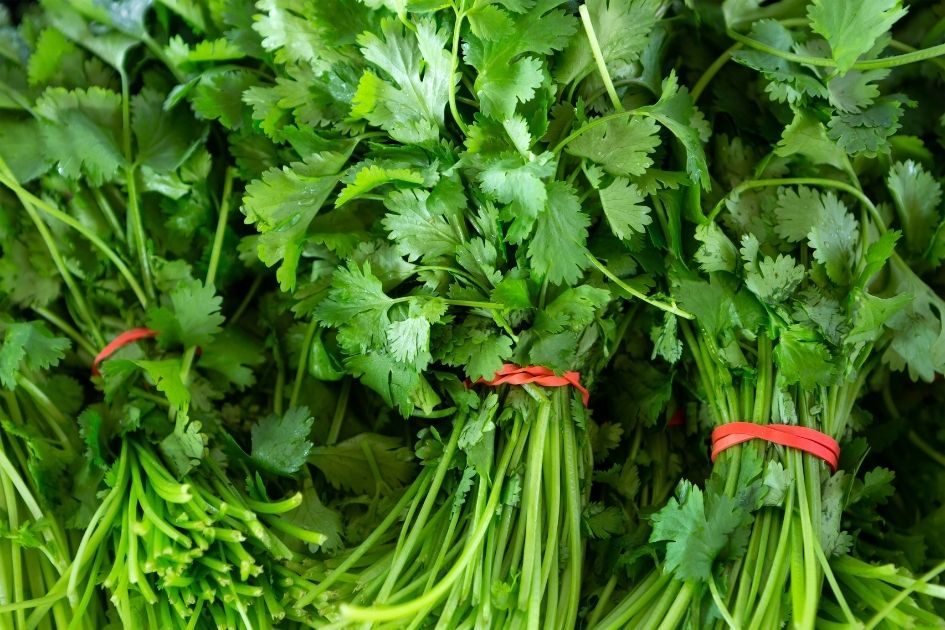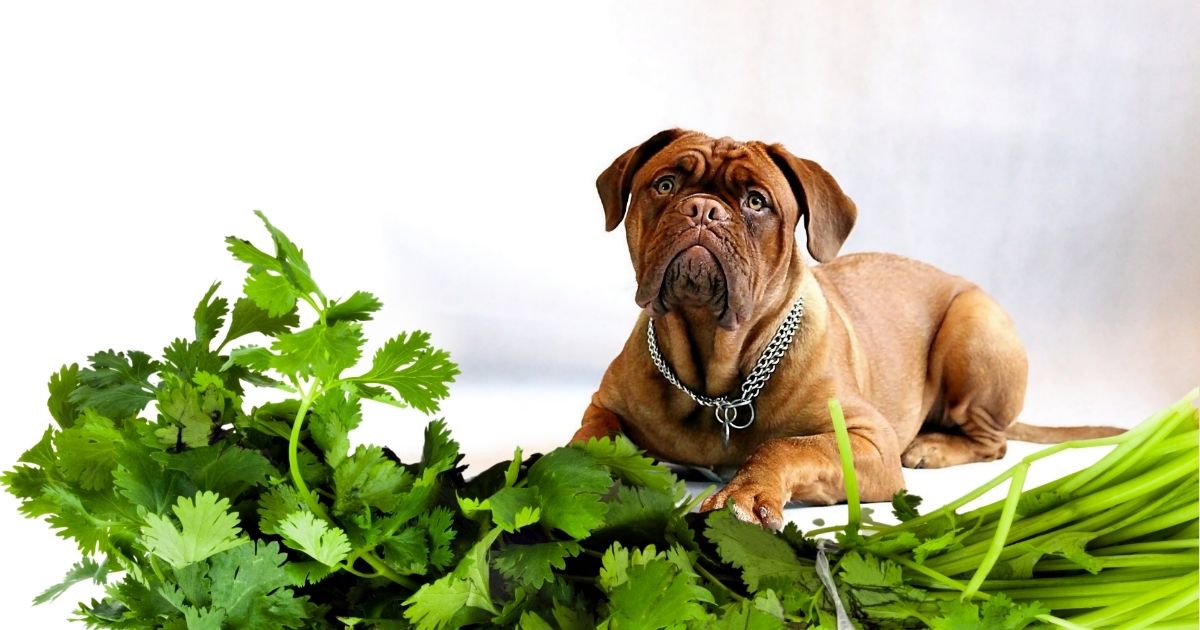Wouldn’t it be nice if dogs could eat every human food on the menu? Sharing would be easier, and you could have a snack feast with your companion.
Unfortunately, that’s not the case, especially with fruits and vegetables.
But, can dogs eat cilantro?
Cilantro is one vegetable you may be tempted to give your dog because of its perceived benefits, but you may not be sure if it will be profitable for your furry buddy.
That concern is not unfounded. The wrong vegetable, fruit, or any other human food can affect a dog badly.
Do not assume that what you consider healthy will be the same for your pet pooch.
Complications can range from mild to severe, and that seemingly harmless meal could be the reason for an unforeseen canine burial.
Pardon the morbidity, but feeding is crucial to a dog’s well-being.
Fortunately, you don’t need to worry about your dog’s life span when feeding him cilantro. On the contrary, cilantro may increase the chances of your dog living long.
You should be careful, though. Good turning evil doesn’t only happen in Hollywood.
In this article, we’ll look into the components of cilantro, some encouraging points, a fair warning, and other tips that will help if you decide to add cilantro to Jackie’s diet.
Cilantro: An Overview
The stats on cilantro makes it both interesting and controversial. When it comes to taste, two parties stand strong.
One can’t stand the taste of this herb, the other can’t comprehend what’s bad about it.
Many factors have their hands in this silent competition—including environment, culture, and genetics—and there remains no consensus on the matter of taste.
That said, cilantro is well known, sometimes by its second name Coriander. It comes from the Coriander plant and belongs to the parsley family.
There’s so much we gain from the Coriander plant. In addition to using the leaf, we make coriander spice out of the seeds and even use the roots as ingredients.
Cilantro is a common ingredient in Mexican recipes and appears a lot in Mexican salsa. It has also been used in other cuisines, including Moroccan and Indian.
Here is the nutritional value of a 100g cilantro:
| Nutritional Info | Amount |
|---|---|
| Calories | 23 |
| Fat | 0.52g |
| Cholesterol | 0g |
| Sodium | 46mg |
| Carbohydrates | 3.67g |
| Protein | 2.13g |
| Calcium | 67mg |
| Potassium | 521mg |
| Vitamin A | 37% |
| Vitamin C | 30% |

Now that we have an idea of the components of cilantro, let’s get into our main discussion.
Can Dogs Eat Cilantro?
A direct answer to the question is a yes. Dogs can eat cilantro and may have a good time while doing so, but it doesn’t stop here.
Cilantro isn’t what you’d first think of when considering dog food, and there are good reasons for it. Vegetables don’t form a dog’s core diet, and cilantro cannot fill that role.
If you want to feed your dog cilantro, it is best to make it a treat or a snack.
That aside, cilantro has some good gifts to offer dogs, so it isn’t a total waste for your poochie to have one.
Just as it boosts a human’s immune system and forestall some diseases, cilantro is a bonus to a dog’s health.
Why Cilantro is OK for Dogs
Here are some benefits your dog will enjoy from cilantro. With this herb, you have an opportunity to give your dog a healthy touch. The benefits are:
1. It helps with that bad breath
If your doggy is feeling reluctant to get some dental care and his mouth smells like he feasted on dead frogs, get him some cilantro.
It improves a dog’s breath and gets rid of any pungent smell.
Cilantro also plays the role of a dentist by strengthening your dog’s gums and preventing any dental issues.
2. It strengthens weak eyes and beautifies the skin
As we saw on the nutritional list, cilantro contains a decent percentage of vitamin A. This vitamin is instrumental for better eyesight, both for dogs and humans.
Vitamin A goes beyond the ocular, though. The skin and coat benefit too. Vitamin A is essential to dogs, and cilantro has it.
3. There are other vitamins and minerals, too
Added to vitamin A are some other vitamins and minerals that your dog will do better with. They include Vitamin C, Vitamin K, calcium, iron, and magnesium.
Collectively, these vitamins and minerals work on a dog’s bones, blood vessels, red blood cells, skin, and teeth.
4. Cilantro is good for your dog’s digestive system
Cilantro is a good remedy for dogs with stomach upset, diarrhea, or some other digestive issues.
To its credit, cilantro has many years of experience being a good source of treatment for digestive complications in humans. Why not humans?
5. It fights against infections
Most dogs are susceptible to infections, some more than others.
Cilantro is equipped with many antifungal and antibacterial weapons, which spells bad news for the bacteria, but possible relief for an ailing dog.
6. It detoxifies the dog’s body
Cilantro acts as a detox, removing metal toxins from a dog’s body as it does with humans. It also helps with natural defecation.
7. It aids with doggy insomnia
Sick dogs may suffer from insomnia due to pain and other symptoms. Senior dogs sometimes have trouble sleeping too.
Cilantro helps a dog with this issue by inducing sleep.
Is Cilantro Bad for Dogs?
The disadvantages of cilantro are not frequent and are avoidable, but cilantro has some weaknesses.
The major one is its effect on dogs with allergies. Some dogs may react to cilantro, displaying symptoms like skin itches, swelling of some body parts, and rashes.
Overeating this herb may also put your dog in a bad place health-wise. It can cause an upset stomach, vomiting, and diarrhea.
The best way to minimize the chances of your dog suffering from these side effects is by taking slow steps.
When you want to introduce any meal to a dog, you should ensure they won’t react negatively to the meal. Cilantro is no exception.
Have a veterinarian on standby and start with a little amount. This would also help you determine if the dog will enjoy it. As we will soon see, cilantro isn’t every dog’s favorite.
Dogs and Cilantro: Do they Like it?
Like humans, dogs have no universal love for cilantro. It isn’t chicken, turkey, or even the unhealthy fried foods that dogs love to get their paws on.
Related: Can Dogs Eat French Fries?
Some dogs will appreciate the strong flavor of cilantro, others may wonder if you made a mistake with their meal.
The best way to find out is through experiment and observation. Start by adding a little to your dog’s main diet and watch his reaction.
Does he go out of his way to avoid the strange leaves or does he chew it up with everything else?
Having said that, you can influence his choice with the manner you prepare and serve cilantro to him.
How to Prepare Cilantro for a Dog
There are many creative ways you can add cilantro to a dog’s diet, and break any monotonous repetition in his meal plan.
You should be careful not to add any harmful ingredients to the meal, lest you foil your plans and make the whole cilantro package unhealthy for your pet pooch.
Salt, seasonings, and any form of spice should not be used.
You can add cilantro to a dish of chicken and offer it to your dog. Chicken is a popular, safe, and nutritious meal for dogs.
Another good recipe to try out is pork cooked with rice and some cilantro sprinkled on it.
In any case, get creative and you may be surprised what you come up with.
How to Serve Cilantro to Dogs

Cilantro comes in many forms. It could be powdery, leafy, stem, or in seed form. Leaves are more recommended because they retain vitamins, unlike other forms.
There are many ways you can serve cilantro to a dog. Here are some of them:
- You can add it to his main meal. This is the healthiest form and comes highly recommended.
- You can make a meal for yourself with cilantro and share it with your pet. Remember not to use any salt or spices.
- You can get cilantro in oily form and add it to your dog’s water bowl. This is advisable if you feel your dog has a sensitive stomach.
- The final method is to get powdery cilantro and mix it with a dog’s wet food.
How Much Cilantro is Safe for Dogs?
So far, we’ve established that dogs can eat cilantro as it is nutritious to them. We’ve looked into the pros and cons, as well as tips on preparing and serving this herb to dogs.
We’ll need to answer a final question which you should know for your dog’s safety: how much cilantro is safe for dogs?
A pinch of cilantro is a good start for dogs of any size. If you notice your pet likes the taste, take it up a notch.
Keep his size in mind as you do this, so you won’t overfeed him. Before introducing this to your dog, get more advice from a veterinarian.
FAQs
Can dogs eat parsley and cilantro?
In adequate portions, cilantro and other plants in the parsley family are good for dogs. Cilantro in particular furnishes enough valuable nutrients to any dog that eats it the right way.
Can dogs taste cilantro?
While other spices tend to be hot and peppery, cilantro isn’t. Your dog can have a taste of it. However, some may not like the taste. Do not push further if your dog falls under this category.
What happens if a dog eats cilantro?
Cilantro is not a toxic meal to dogs, so you may not have any serious problems if your dog eats cilantro.
However, he may display abnormal symptoms if he is allergic or ate more than a moderate amount. If your dog shows any odd signs, take him to the vet.
What herbs can dogs eat safely?
Many herbs are healthy for dogs, and you can consider introducing them to your pet’s diet. They include aloe vera, basil, cinnamon, ginger, and turmeric.
Wrap Up
Having gotten a satisfactory long answer to the problems of cilantro and dogs, the choice to include this in your pet’s diet is between you and your pooch.
You are the one to know what amount of cilantro is safe for your dog, and he’ll determine whether he’s cool with the taste.
You have many other options of healthy herbs, so you can try another if cilantro did not work out for your pet pooch.
You May Also Like: Can Dogs Eat Edamame? (Beans, Pods, Raw, Cooked)







